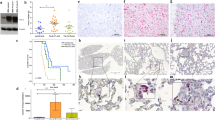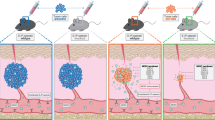Abstract
Lung metastasis remains the major cause of cancer related mortality in patients with breast, gastrointestinal, sarcoma, melanoma and kidney cancer. Here we characterize the expression of selectins during metastatic lung colonization and analyzed their function in the formation of pulmonary metastasis. E-selectin, together with VCAM-1, were detected 6 h after the microvascular arrest of tumor cells indicating an inflammatory activation of the local endothelial cells. No E-selectin expression was detected in pre-metastatic lungs of mice carrying primary tumors. P- and L-selectin were present during initiating steps of lung colonization and correlated with the recruitment of platelets and leukocytes to metastatic tumor cells. Experimental metastasis was significantly reduced in the absence of P- or L-selectin while no attenuation of metastasis was observed in E-selectin-deficient mice. Collectively, selectins are upregulated within the metastatic microenvironment of tumor cells and the formation of a permissive metastatic microenvironment is facilitated by P- and L-selectin mediated interactions between tumor cells and blood components. E-selectin does not affect metastatic initiation in the lung tissue and its expression rather indicates a local activation of lung microvascular endothelial cells.






Similar content being viewed by others

References
Gupta GP, Massague J (2006) Cancer metastasis: building a framework. Cell 127:679–695
Steeg PS (2006) Tumor metastasis: mechanistic insights and clinical challenges. Nat Med 12:895–904
Chambers AF, Groom AC, MacDonald IC (2002) Dissemination and growth of cancer cells in metastatic sites. Nat Rev Cancer 2:563–572
Pantel K, Brakenhoff RH (2004) Dissecting the metastatic cascade. Nat Rev Cancer 4:448–456
Liotta LA, Kohn EC (2001) The microenvironment of the tumour-host interface. Nature 411:375–379
Fidler IJ (2003) The pathogenesis of cancer metastasis: the ‘seed and soil’ hypothesis revisited. Nat Rev Cancer 3:453–458
Joyce JA, Pollard JW (2009) Microenvironmental regulation of metastasis. Nat Rev Cancer 9:239–252
Husemann Y, Geigl JB, Schubert F et al (2008) Systemic spread is an early step in breast cancer. Cancer Cell 13:58–68
Kang Y, Siegel PM, Shu W et al (2003) A multigenic program mediating breast cancer metastasis to bone. Cancer Cell 3:537–549
Gupta GP, Nguyen DX, Chiang AC et al (2007) Mediators of vascular remodelling co-opted for sequential steps in lung metastasis. Nature 446:765–770
Bos PD, Zhang XH, Nadal C et al (2009) Genes that mediate breast cancer metastasis to the brain. Nature 459:1005–1009
Cines DB, Pollak ES, Buck CA et al (1998) Endothelial cells in physiology and in the pathophysiology of vascular disorders. Blood 91:3527–3561
Orr FW, Wang HH, Lafrenie RM, Scherbarth S, Nance DM (2000) Interactions between cancer cells and the endothelium in metastasis. J Pathol 190:310–329
Nash GF, Turner LF, Scully MF, Kakkar AK (2002) Platelets and cancer. Lancet Oncol 3:425–430
Nierodzik ML, Karpatkin S (2006) Thrombin induces tumor growth, metastasis, and angiogenesis: evidence for a thrombin-regulated dormant tumor phenotype. Cancer Cell 10:355–362
Laubli H, Borsig L (2009) Heparins attenuate cancer metastasis: are selectins the link? Cancer Invest 27:474–481
Nieswandt B, Hafner M, Echtenacher B, Mannel DN (1999) Lysis of tumor cells by natural killer cells in mice is impeded by platelets. Cancer Res 59:1295–1300
Palumbo JS, Talmage KE, Massari JV et al (2005) Platelets and fibrin(ogen) increase metastatic potential by impeding natural killer cell-mediated elimination of tumor cells. Blood 105:178–185
Borsig L, Wong R, Hynes RO, Varki NM, Varki A (2002) Synergistic effects of L- and P-selectin in facilitating tumor metastasis can involve non-mucin ligands and implicate leukocytes as enhancers of metastasis. Proc Natl Acad Sci USA 99:2193–2198
Liang S, Sharma A, Peng HH, Robertson G, Dong C (2007) Targeting mutant (V600E) B-Raf in melanoma interrupts immunoediting of leukocyte functions and melanoma extravasation. Cancer Res 67:5814–5820
Laubli H, Stevenson JL, Varki A, Varki NM, Borsig L (2006) L-selectin facilitation of metastasis involves temporal induction of fut7-dependent ligands at sites of tumor cell arrest. Cancer Res 66:1536–1542
Kim S, Takahashi H, Lin WW et al (2009) Carcinoma-produced factors activate myeloid cells through TLR2 to stimulate metastasis. Nature 457:102–106
Laubli H, Spanaus KS, Borsig L (2009) Selectin-mediated activation of endothelial cells induces expression of CCL5 and promotes metastasis through recruitment of monocytes. Blood 114:4583–4591
Borsig L, Wong R, Feramisco J et al (2001) Heparin and cancer revisited: mechanistic connections involving platelets, P-selectin, carcinoma mucins, and tumor metastasis. Proc Natl Acad Sci USA 98:3352–3357
Stevenson JL, Choi SH, Varki A (2005) Differential metastasis inhibition by clinically relevant levels of heparins–correlation with selectin inhibition, not antithrombotic activity. Clin Cancer Res 11:7003–7011
Hostettler N, Naggi A, Torri G et al (2007) P-selectin- and heparanase-dependent antimetastatic activity of non-anticoagulant heparins. FASEB J 21:3562–3572
McEver RP (2002) Selectins: lectins that initiate cell adhesion under flow. Curr Opin Cell Biol 14:581–586
Auguste P, Fallavollita L, Wang N et al (2007) The host inflammatory response promotes liver metastasis by increasing tumor cell arrest and extravasation. Am J Pathol 170:1781–1792
Scamuffa N, Siegfried G, Bontemps Y et al (2008) Selective inhibition of proprotein convertases represses the metastatic potential of human colorectal tumor cells. J Clin Invest 118:352–363
Vidal-Vanaclocha F, Fantuzzi G, Mendoza L et al (2000) IL-18 regulates IL-1beta-dependent hepatic melanoma metastasis via vascular cell adhesion molecule-1. Proc Natl Acad Sci USA 97:734–739
Brodt P, Fallavollita L, Bresalier RS et al (1997) Liver endothelial E-selectin mediates carcinoma cell adhesion and promotes liver metastasis. Int J Cancer 71:612–619
Biancone L, Araki M, Araki K, Vassalli P, Stamenkovic I (1996) Redirection of tumor metastasis by expression of E-selectin in vivo. J Exp Med 183:581–587
Khatib AM, Auguste P, Fallavollita L et al (2005) Characterization of the host proinflammatory response to tumor cells during the initial stages of liver metastasis. Am J Pathol 167:749–759
Kaplan RN, Riba RD, Zacharoulis S et al (2005) VEGFR1-positive haematopoietic bone marrow progenitors initiate the pre-metastatic niche. Nature 438:820–827
Hiratsuka S, Nakamura K, Iwai S et al (2002) MMP9 induction by vascular endothelial growth factor receptor-1 is involved in lung-specific metastasis. Cancer Cell 2:289–300
Hiratsuka S, Watanabe A, Aburatani H, Maru Y (2006) Tumour-mediated upregulation of chemoattractants and recruitment of myeloid cells predetermines lung metastasis. Nat Cell Biol 8:1369–1375
Erler JT, Bennewith KL, Cox TR et al (2009) Hypoxia-induced lysyl oxidase is a critical mediator of bone marrow cell recruitment to form the premetastatic niche. Cancer Cell 15:35–44
Garcia J, Callewaert N, Borsig L (2007) P-selectin mediates metastatic progression through binding to sulfatides on carcinoma cells. Glycobiology 17:185–196
Ludwig RJ, Boehme B, Podda M et al (2004) Endothelial P-selectin as a target of heparin action in experimental melanoma lung metastasis. Cancer Res 64:2743–2750
Mannori G, Santoro D, Carter L et al (1997) Inhibition of colon carcinoma cell lung colony formation by a soluble form of E-selectin. Am J Pathol 151:233–243
Khatib AM, Fallavollita L, Wancewicz EV, Monia BP, Brodt P (2002) Inhibition of hepatic endothelial E-selectin expression by C-raf antisense oligonucleotides blocks colorectal carcinoma liver metastasis. Cancer Res 62:5393–5398
Laferriere J, Houle F, Taher MM, Valerie K, Huot J (2001) Transendothelial migration of colon carcinoma cells requires expression of E-selectin by endothelial cells and activation of stress-activated protein kinase-2 (SAPK2/p38) in the tumor cells. J Biol Chem 276:33762–33772
Tremblay PL, Auger FA, Huot J (2006) Regulation of transendothelial migration of colon cancer cells by E-selectin-mediated activation of p38 and ERK MAP kinases. Oncogene
Hanley WD, Burdick MM, Konstantopoulos K, Sackstein R (2005) CD44 on LS174T colon carcinoma cells possesses E-selectin ligand activity. Cancer Res 65:5812–5817
Burdick MM, McCaffery JM, Kim YS, Bochner BS, Konstantopoulos K (2003) Colon carcinoma cell glycolipids, integrins, and other glycoproteins mediate adhesion to HUVECs under flow. Am J Physiol Cell Physiol 284:C977–C987
Fukuda MN, Ohyama C, Lowitz K et al (2000) A peptide mimic of E-selectin ligand inhibits sialyl Lewis X-dependent lung colonization of tumor cells. Cancer Res 60:450–456
Camerer E, Qazi AA, Duong DN et al (2004) Platelets, protease-activated receptors, and fibrinogen in hematogenous metastasis. Blood 104:397–401
Gasic GJ, Tuszynski GP, Gorelik E (1986) Interaction of the hemostatic and immune systems in the metastatic spread of tumor cells. Int Rev Exp Pathol 29:173–212
Borsig L (2008) The role of platelet activation in tumor metastasis. Expert Rev Anticancer Ther 8:1247–1255
Ludwig RJ, Alban S, Bistrian R et al (2006) The ability of different forms of heparins to suppress P-selectin function in vitro correlates to their inhibitory capacity on bloodborne metastasis in vivo. Thromb Haemost 95:535–540
Grivennikov S, Karin E, Terzic J et al (2009) IL-6 and Stat3 are required for survival of intestinal epithelial cells and development of colitis-associated cancer. Cancer Cell 15:103–113
Qian B, Deng Y, Im JH et al (2009) A distinct macrophage population mediates metastatic breast cancer cell extravasation, establishment and growth. PLoS ONE 4:e6562
Acknowledgements
We thank Eliene O. Kozlowski de Farias for technical assistance. This work was supported by grants from Swiss National Foundation #3100A0-116295 (to L.B.), and from University of Zurich and ZIHP (to H.L.).
Author information
Authors and Affiliations
Corresponding author
Electronic supplementary material
Below is the link to the electronic supplementary material.
Supplementary Figure 1
Lung sections of mice subcutaneously injected with 3LL Lewis lung carcinoma cells. Mice were terminated after 24 days and cryosections of lungs were stained with Hematoxilin & Eosin. Representative images of four different mouse specimens are shown. Bar = 100 μm (JPEG 1062 kb)
Rights and permissions
About this article
Cite this article
Läubli, H., Borsig, L. Selectins as Mediators of Lung Metastasis. Cancer Microenvironment 3, 97–105 (2010). https://doi.org/10.1007/s12307-010-0043-6
Received:
Accepted:
Published:
Issue Date:
DOI: https://doi.org/10.1007/s12307-010-0043-6



